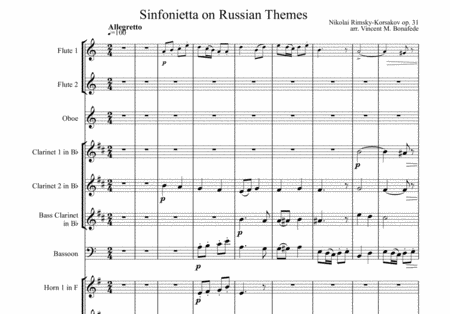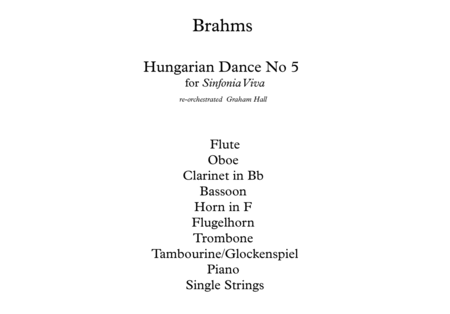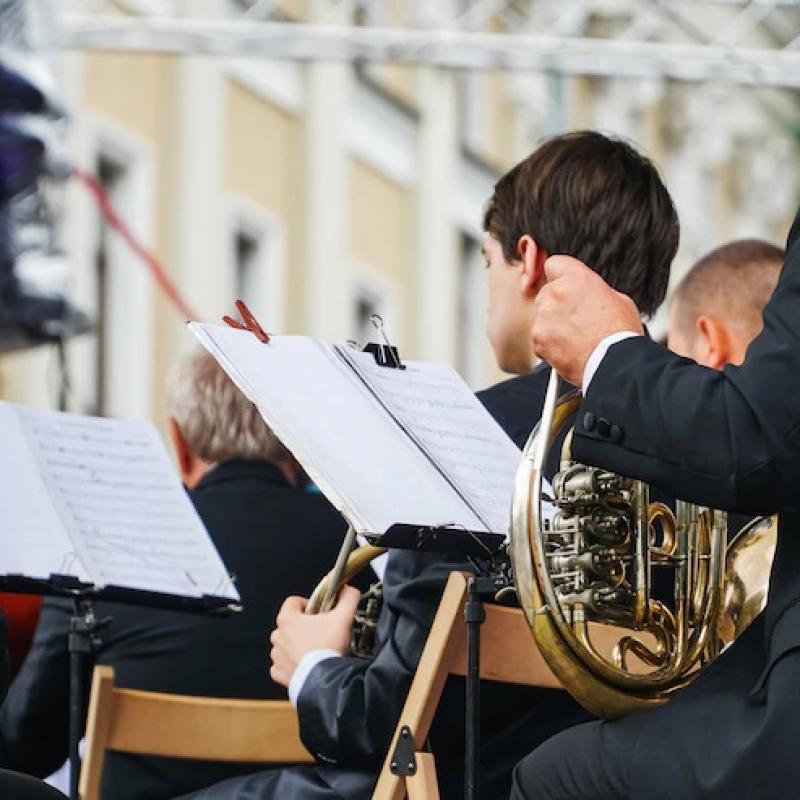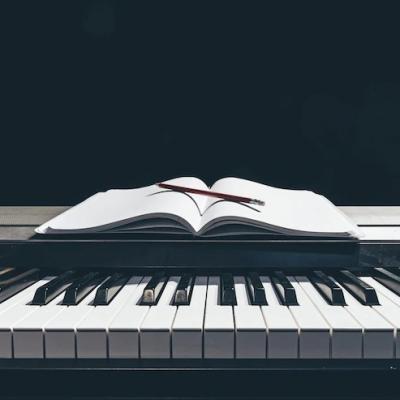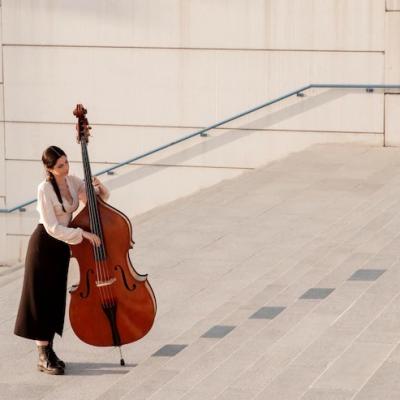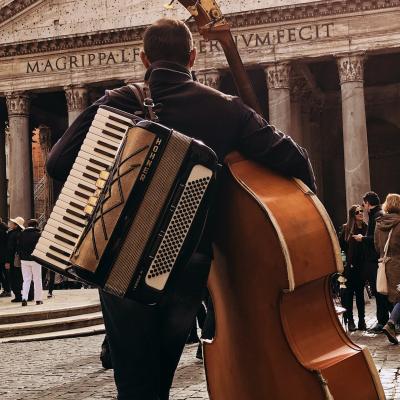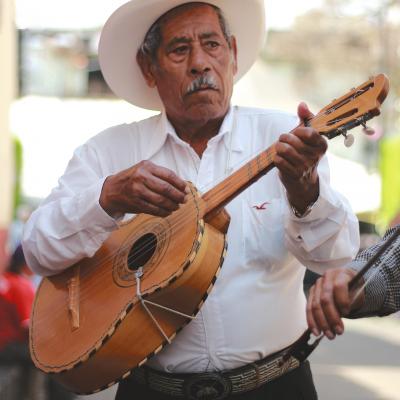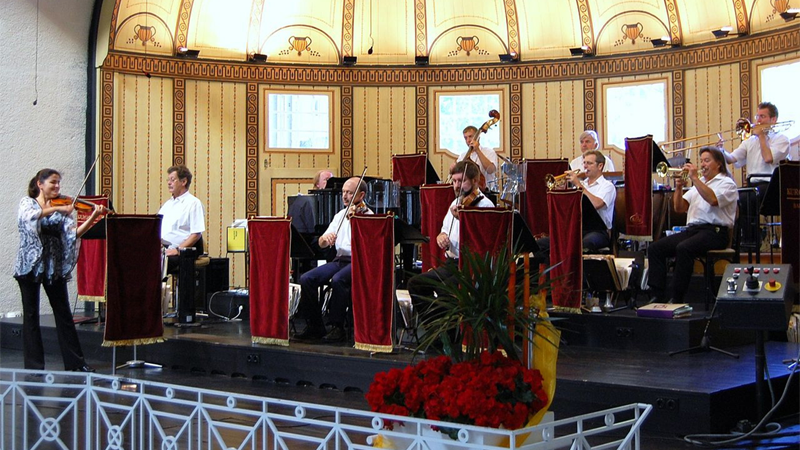 Sinfonietta is a musical term that refers to a small symphony or orchestral work, typically consisting of three to five movements, that is shorter in duration and usually less complex than a full symphony. The word "sinfonietta" is derived from the Italian word "sinfonia," which means symphony. This term implies both an orchestral consistency and a definite form or structure of the piece, so composers have been naming sinfonietta anything that didn't fall in this frame, even if using the full orchestra.
Sinfonietta is a musical term that refers to a small symphony or orchestral work, typically consisting of three to five movements, that is shorter in duration and usually less complex than a full symphony. The word "sinfonietta" is derived from the Italian word "sinfonia," which means symphony. This term implies both an orchestral consistency and a definite form or structure of the piece, so composers have been naming sinfonietta anything that didn't fall in this frame, even if using the full orchestra.
The term "sinfonietta" was first used in the 18th century to describe smaller, lighter orchestral works that were often used as overtures to operas or as standalone concert pieces.
As an extension today, a sinfonietta is an orchestra smaller than a symphony orchestra, which means it has fewer winds and brass and proportionally also less strings, while including sometimes non orchestral instruments, like the piano.
Subscribe to our Newsletter
Ensemble lineup
Sinfoniettas can vary in instrumentation and style, but they generally feature a smaller ensemble than a full symphony orchestra, with fewer players for each instrument. This can lead to a more transparent sound and greater clarity of individual lines. The specific lineup of a sinfonietta can vary depending on the composition being performed, but a typical sinfonietta might include the following instruments:
- Strings: Violins, violas, cellos, and double basses
- Woodwinds: Flutes, oboes, clarinets, and bassoons
- Brass: Trumpets, horns, trombones, and sometimes a tuba
- Percussion: Timpani, snare drum, cymbals, and other percussion instruments
Some compositions may also include other instruments, such as harp, piano, or additional percussion. The exact lineup can also be influenced by the specific needs of the piece being performed, as well as the preferences of the composer and conductor.
This type of arrangement was very popular in the last centuries, where events, balls and social gathering were entertained by small salon orchestras, which proposed the most famous contemporary works, often arranged for each specific type of ensemble. This led to the formation of a peculiar technology for writing music for these ensembles, which allowed to perform them with any number of instruments.
To allow for this type of flexibility, the salon orchestras had quite a different structure than a sinfonietta. The conductor was the principal violinist, who also played all types of solos, while the harmony and rythm was carried out by a piano player. Then other instruments were added in this order: cello, clarinet, double bass, second violin, flute, percussion, horn, brass, oboe and so on, depending on the desired size. An important instrument in this type of orchestra was the pedal harmonium, which provided a bit of body to the clear sound of the orchestra.

Repertoire
The repertoire of these smaller ensembles was quite extensive, including classical, opera, ballet and orchestral works, which are often characterized by their fast-paced, energetic rhythms and lively melodies, although they can also be more introspective and reflective in mood. The greatest and most performed composers of this era would be the Strauss family, which for generation provided music material for the entertainment of the high society of that times, which was then arranged and performed in a great number of forms and venues, a tradition that still holds true.
In the 20th century, composers such as Igor Stravinsky and Benjamin Britten popularized the sinfonietta as a genre in its own right, often using it as a vehicle for experimentation and exploration of new musical ideas.
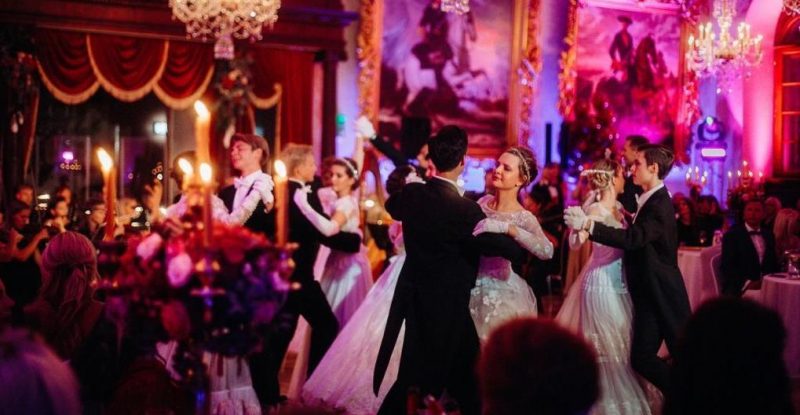
Classical Sinfoniettas
There are many famous sinfoniettas in the classical music repertoire, composed by a variety of composers from different eras. Here are a few examples:
Leos Janacek
Sinfonietta
The Janáček Sinfonietta is a piece of classical music composed by the Czech composer Leoš Janáček. It was written in 1926 and is one of his most famous works. It is scored for a large orchestra, including a brass section of 12 trumpets, 4 trombones, and 2 tubas, which gives the piece its distinctive sound. The piece is in five movements, each with a different character and tempo.
The first movement is marked "Allegretto," and it features a lively and playful theme that is passed around the orchestra. The second movement is marked "Andante," and it has a more melancholy character, with a beautiful lyrical melody played by the woodwinds. The third movement is marked "Moderato," and it features a grand and majestic theme played by the brass. The fourth movement is marked "Allegretto," and it is a playful and energetic dance-like movement with a driving rhythm. The final movement is marked "Andante con moto," and it begins with a quiet and mysterious theme played by the strings.
The piece builds to a powerful climax, with the brass section returning to play the majestic theme from the third movement. The Janáček Sinfonietta is a challenging piece to perform, particularly because of the demands it places on the brass section. It is also a very exciting and rewarding piece to listen to, with its bold and colorful orchestration and its lively and engaging melodies.
Benjamin Britten
Sinfonietta op. 1
The Britten Sinfonietta is a musical work composed by British composer Benjamin Britten. It was written in 1932, when Britten was just 19 years old, and was premiered in 1933 at a concert of the Norwich Festival. The Sinfonietta is written for a chamber orchestra consisting of two flutes, two oboes, two clarinets, two bassoons, two horns, and strings. The work is in three movements: Allegro maestoso Allegretto Presto con brio The first movement is characterized by a driving, rhythmic energy and a memorable main theme that is stated in unison by the strings at the outset. The second movement is more subdued, with a lyrical melody that is passed around among the various instruments of the orchestra. The final movement is a virtuosic tour-de-force that features rapid-fire exchanges between the various sections of the orchestra. The Britten Sinfonietta is notable for its skillful orchestration and its lively, energetic character. Despite its relatively early composition date, the work already displays many of the hallmarks of Britten's mature style, including his penchant for inventive harmonic progressions and rhythmic vitality.
Dmitri Shostakovich
Sinfonietta op. 110
The Shostakovich Sinfonietta is a piece of music composed by the Russian composer Dmitri Shostakovich in 1934. It is a short work for orchestra that consists of five movements: 1. Allegretto 2. Andante 3. Allegro 4. Lento - Allegretto 5. Allegro molto
The piece was originally composed as a graduation work for the Leningrad Conservatory, where Shostakovich studied from 1919 to 1925. However, it was never performed during his lifetime and was only premiered in 1989, nearly 50 years after it was written. The Shostakovich Sinfonietta is known for its playful and energetic style, which is typical of Shostakovich's early works. It showcases the composer's skillful use of orchestration and his ability to create vivid musical imagery. Overall, the Shostakovich Sinfonietta is a delightful and engaging piece of music that is well worth listening to for fans of classical music.
Sergei Prokofiev
Sinfonietta
The Prokofiev Sinfonietta, also known as the Classical Symphony, is a work by the Russian composer Sergei Prokofiev. It was composed in 1916 and is one of his most popular and frequently performed works. The Sinfonietta is scored for a small orchestra consisting of two flutes, two oboes, two clarinets, two bassoons, two horns, two trumpets, timpani, and strings. The work is in four movements: Allegro Larghetto Gavotte: Non troppo allegro Finale: Molto vivace The work is modeled after the classical symphonies of Haydn and Mozart, but with Prokofiev's own unique style and musical language. The first movement is lively and energetic, with a memorable main theme. The second movement is a lyrical and expressive slow movement, while the third movement is a charming gavotte. The final movement is a fast and frenetic tour de force that showcases the technical abilities of the performers. The Sinfonietta was well-received upon its premiere, and it remains a popular and frequently performed work in the classical repertoire today.
Francis Poulenc
Sinfonietta
composed by French composer Francis Poulenc in 1947, it is scored for a chamber orchestra consisting of two flutes, two oboes, two clarinets, two bassoons, two horns, two trumpets, timpani, and strings. The Sinfonietta is a neoclassical work that draws on Poulenc's signature style, which blends elements of both French and Stravinskian music. It is divided into three movements, and each movement showcases Poulenc's mastery of orchestration, melody, and rhythm. The Sinfonietta has become a staple of the chamber orchestra repertoire and is widely considered one of Poulenc's most important works. Its combination of neoclassical form and modernist harmonies has made it a favorite among musicians and audiences alike.
Nikolaj Andreevič Rimskij-Korsakov
Sinfonietta on Russian Themes op. 31
The Sinfonietta on Russian Themes is a composition by Russian composer Nikolai Rimsky-Korsakov. It was composed in 1885 and is one of his most popular works. The Sinfonietta is a four-movement piece that showcases Rimsky-Korsakov's masterful orchestration skills and his interest in Russian folk music. The first movement, "Allegro," features a lively and energetic theme that is developed throughout the movement. The second movement, "Scherzo," is a playful and dance-like piece that incorporates Russian folk melodies. The third movement, "Andante," is a lyrical and romantic piece that highlights the beauty of the orchestra's string section. The final movement, "Allegro con spirito," is a lively and festive piece that brings the Sinfonietta to a thrilling conclusion. Overall, the Sinfonietta on Russian Themes is a wonderful example of Rimsky-Korsakov's ability to combine traditional Russian music with the Western classical tradition. Its colorful and vibrant orchestration, combined with its folk-inspired melodies, make it a joy to listen to and a true masterpiece of Russian classical music.
Salon Music
The repertoire of the salon orchestra is as wide as imaginable, but it is somehow limited to the music that was popular during the 19th and the first part of the 20th century. The main purposes of this music were entertainment and ball, so nobody would have arranged a piece that was not popular and contemporary in the society of that time. So it is peculiar for much of the previous classical music to be not present in this repertoire, while other unknown authors were incredibly popular and performed everywhere. One could say they didn't pass the proof of time, as it happens for much of the music of all times. It was a thriving, interesting, always up to date repertoire, which was then published and distributed by specialized conpanies. Most of this has disappeared today, except in specific cultural areas where it is still possible to get this type of entertainment., namely in german-speaking countries, where this tradition is continued in thermal establishments, hotels, parks and venues.
A salon orchestra typically performs light classical music and popular tunes from the late 19th and early 20th centuries. Some common genres and styles of music that might be found in a salon orchestra's repertoire include:
-
Waltzes: These elegant dance pieces originated in Vienna and became popular throughout Europe in the 19th century. Salon orchestras often play waltzes by composers like Johann Strauss Jr. and Franz Lehár.
-
Polkas: Another dance style that originated in central Europe, polkas are lively and playful. Salon orchestras might play polkas by composers like Josef Strauss or Eduard Strauss.
-
Operettas and musicals: Salon orchestras might play instrumental versions of popular songs from operettas and musicals, such as "The Merry Widow" by Franz Lehár or "Show Boat" by Jerome Kern.
-
Tangos: This sensual dance style originated in Argentina and became popular in Europe in the early 20th century. Salon orchestras might play tangos by composers like Astor Piazzolla or Carlos Gardel.
-
Jazz standards: Some salon orchestras might incorporate jazz standards into their repertoire, playing instrumental versions of songs like "Take the A Train" by Duke Ellington or "Fly Me to the Moon" by Frank Sinatra.
-
Popular songs: Salon orchestras might also play instrumental versions of popular songs from the early 20th century, such as "I Got Rhythm" by George Gershwin or "Blue Skies" by Irving Berlin.
Overall, the repertoire of a salon orchestra is often characterized by its elegance, sophistication, and ability to evoke a sense of nostalgia for a bygone era.
Related Artists
Salon orchestra music was popular in the late 19th and early 20th centuries, particularly in Europe and the United States. The music was typically light and entertaining, and was often played by small ensembles in social settings such as cafes, restaurants, and ballrooms.
Some of the most famous salon orchestra composers include:
Johann Strauss II
Johann Strauss II, also known as the "Waltz King," was a prominent composer of salon orchestra music in the 19th century. He composed numerous waltzes, polkas, and other light music pieces that were well-suited for performance by small ensembles in social settings such as cafes, restaurants, and ballrooms.
Strauss's music was highly popular in Vienna and throughout Europe, and his compositions helped to define the sound of the salon orchestra. His works, which often featured catchy melodies and lively rhythms, were designed to entertain audiences and create a festive atmosphere.
In addition to his waltzes and polkas, Strauss also composed a variety of other pieces that were popular with salon orchestras, including quadrilles, marches, and galops. Some of his most famous works include "The Blue Danube," "Tales from the Vienna Woods," and "Die Fledermaus" ("The Bat").
Franz Lehár
Franz Lehár was an Austro-Hungarian composer of operettas, popular songs, and salon music. He lived from 1870 to 1948 and was one of the most popular and successful composers of his time.
Lehár's operettas were characterized by their catchy tunes, comic plots, and romantic themes. His most famous works include "The Merry Widow," "The Land of Smiles," and "The Count of Luxembourg." These operettas were performed throughout Europe and North America and helped to define the genre.
In addition to his operettas, Lehár also composed numerous songs and pieces of salon music. His most famous songs include "Love's Roundabout," "Yours is My Heart Alone," and "Vilia." These songs were often performed in cafes, restaurants, and other social settings and helped to establish Lehár as a leading composer of salon music.
Lehár's music was known for its charm, elegance, and sentimental appeal. He combined elements of Viennese waltz music, Hungarian folk music, and French operetta to create a unique sound that was beloved by audiences around the world. His influence can be heard in the work of many later composers, including Richard Rodgers and Cole Porter.
Johannes Brahms
While Johannes Brahms is not typically associated with salon orchestra music, some of his compositions have been arranged for salon orchestras. Brahms was a German composer who lived in the 19th century, and his music is generally considered to be more serious and complex than the light classical pieces that are often played by salon orchestras.
https://www.sheetmusicdirect.com/en-US/se/ID_No/897245/Product.aspx
Franz von Stolz
Also an Austrian composer, conductor, and pianist who was active during the early 20th century. He was known for his contributions to operetta, film music, and salon music, and was particularly popular in Vienna.
Stolz composed numerous waltzes, polkas, and other light music pieces that were often performed by salon orchestras. Some of his most famous works include "Im Prater blüh'n wieder die Bäume" ("In the Prater the Trees are Blooming Again"), "Adieu, mein kleiner Gardeoffizier" ("Farewell, My Little Guard Officer"), and "Zwei Herzen im Dreivierteltakt" ("Two Hearts in Waltz Time").
Performers
Salon orchestras are not as popular today as they were in the past, but there are still some groups that perform this style of music. Many of these groups are made up of professional musicians who specialize in early 20th-century music or who have a particular interest in the salon orchestra repertoire.
Here are some examples of salon orchestras from around the world that are still active today:
- New York Salon Orchestra (USA)
- Awesöme Orchestra (USA)
- Salon Orchestra of Washington (USA)
- Berliner Salonkonzert Orchestra (Germany)
- Kurpfälzisches Kammerorchester Mannheim (Germany)
- Salonorchester Alt Wien (Austria)
- The Strings of Paris (France)
- Salon Orchestra Amsterdam (Netherlands)
- Belvedere Chamber Orchestra (UK)
- The Strauss Symphony of America (USA)
- Sinfonietta Ensemble (ITA)
André Rieu
One of the most famous artists which continue this tradition is André Rieu, which performs these classics with huge orchestras in costume for the viennese public, with great and long lasting success, giving a new life to a world which would otherwise disappear.

André Rieu was born into a musical family in Maastricht, Netherlands. His father was a conductor and his mother was a singer. Rieu started playing the violin at the age of five and went on to study music at the Conservatoire Royal in Liège, Belgium.
After completing his studies, Rieu started performing with various orchestras in the Netherlands and abroad. In 1987, he founded the Johann Strauss Orchestra, which was named after the famous Austrian composer. The orchestra, which originally consisted of just 12 musicians, has now grown to include over 60 musicians.
Rieu's performances with the Johann Strauss Orchestra are known for their theatricality and grandeur. He often performs in elaborate costumes and stages his concerts like theatrical productions. His music style is a blend of classical music, waltzes, and pop music, which has broadened the appeal of classical music to a wider audience.
Rieu has released over 60 albums, many of which have topped the charts in various countries around the world. He has also performed in many famous venues, including the Royal Albert Hall in London, the Radio City Music Hall in New York, and the Sydney Opera House in Australia.
Some of Rieu's most famous performances include his rendition of "The Second Waltz," which was composed by Russian composer Dmitri Shostakovich, and his interpretation of "The Blue Danube," which was composed by Johann Strauss II. Rieu has also collaborated with many famous artists, including the Italian tenor Luciano Pavarotti and the American singer-songwriter Jermaine Jackson.
In addition to his music career, Rieu is also involved in various charitable causes. He founded the André Rieu Foundation, which supports various charities and organizations around the world, including orphanages, schools, and hospitals.
Overall, André Rieu has become one of the most successful classical musicians of our time, and his music and performances continue to entertain and delight audiences around the world.


